As technological advancements increasingly correspond with urban planning, visionaries attempt to introduce these changes to urban centres throughout the globe. Improvements in technology, transport, and sustainability are at the centre of these new cities, while there is also a larger emphasis on embracing the human experience.
The base of Mt. Fuji will soon be home to the Woven City, or the city of the future, brought by the Toyota Motor Corporation. The city will be entirely powered by hydrogen fuel cells, and will be a hub for developing technologies like artificial intelligence, autonomous cars, and smart homes, among other groundbreaking technologies.
James Kuffner, the CEO of Toyota Research Institute-Advanced Development, says “It’s hard to learn something about a smart city if you are only building a smart block.” As more technological advancements emerge in urban planning, it is important to analyze the benefits and potential pitfalls of them in real-life situations. The Woven City will be safer and cleaner than current urban areas, and will also house schools, public safety officials, Toyota employees, and retirees.
The development should conclude by the end of 2020, as two-thousand residents will begin to move in, with more added in subsequent years.
CRE Tech analyses the development of these smart cities, saying:
The announcement by Toyota came a few years after Bill Gates announced his own investment in a smart city in 2017. In the United States state of Arizona, Gates and Microsoft invested $80 million in developing a similar smart city: “The community in Belmont will be designed around high-speed networks, autonomous vehicles, high-speed digital networks, data centres, new manufacturing technologies and autonomous logistics hubs.” Belmont will be built from the ground-up, making it easier to implement new technologies and infrastructures than it would be by retrofitting an existing city to the new advancements.
The smart city trend has become increasingly popular in recent years, as innovators attempt to implement changes that will help battle climate change, public safety, technological changes, and other battles that urban centres face in modern ages.
Global design and architecture firm Gensler, has conducted a multitude of work on defining the city of the future, saying it is entirely centred around people.
Gensler has provided six key principles to the city of the future: placemaking, walkability, sustainability, mixed uses, authenticity, and mobility.
1. Placemaking
The idea of placemaking surrounds context and culture. It seeks to bring the community together through relishing in the existing culture of the area, while also inviting new advancements. This is achieved through the experiential realm, where people can see and feel the existence of culture in their community through thoughtful design.
2. Walkability
Cities of the future will not rely on cars. Citizens should be able to conduct their daily lives by walking and attaining the things they need. Gensler says that parking and service delivery should be placed below ground, so that streets and sidewalks can be wholly used and appreciated by people. Walkability also includes landscaping, where there is an importance in vegetation and the inclusion of the natural environment in urban centres.
3. Sustainability
Smart cities will tackle climate change head on, using traditional responses to local environments. Gensler states that throughout history, cities were planned and built by artisans and craftsmen who used materials that respond to the local climate and its challenges. They claim that this is the pathway to sustainability in modern times as well. New developments in urban centers should strive to achieve LEED-certification in order to be as sustainable as possible.
4. Mixed Uses
In order to provide more housing variety and density, cities should be built around mixed-uses. By doing this, compact development and synergy of uses will be achieved so that residents can find everything they need within a close radius of their homes. Through inclusion of mixed-use properties, people will be encouraged to walk or bike to their destinations, becoming increasingly more active.
5. Authenticity
Gensler states that by blending commerce, culture, and street life, great urban centres are made. These cities are tied to local traditions and appear to have roots in their locations. They have distinctive attributes that make them authentic to where they are, and inimitable elsewhere.
6. Mobility
To move people between locations, cities will offer transit systems, bike paths, ride-sharing, and autonomous vehicles. Utilities and infrastructures will be made more efficient to reduce dependence on natural resources. The advancements in mobility will react to rapid growth in population with ease.
While keeping Gensler’s principles in mind, the developing smart cities will determine how to implement these changes into all urban centres. Through trial and error, advancements will be analyzed and perfected so that they can wholly benefit the human experience, and be incorporated into the cities of the future throughout the globe.
The big question is whether we can apply smart cities lessons to existing cities, rather than start from scratch as has been done in the Woven City or Belmont? Can we reverse decades of poor city planning or short-term thinking? These questions remain.
This is the latest in a series of pre-MIPIM 2020 posts from real estate students at the University of San Diego. More here!
Top Image: Getty Images – kynny



